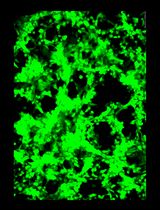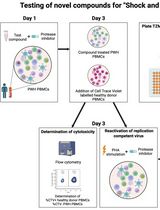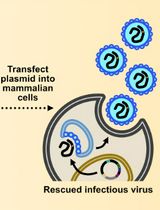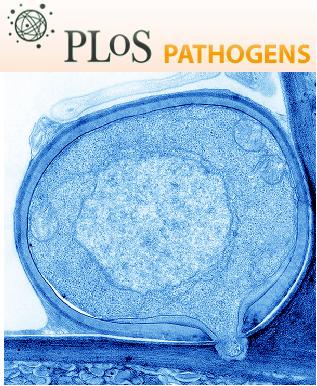- Submit a Protocol
- Receive Our Alerts
- Log in
- /
- Sign up
- My Bio Page
- Edit My Profile
- Change Password
- Log Out
- EN
- EN - English
- CN - 中文
- Protocols
- Articles and Issues
- For Authors
- About
- Become a Reviewer
- EN - English
- CN - 中文
- Home
- Protocols
- Articles and Issues
- For Authors
- About
- Become a Reviewer
Viral Immunofluorescence with Rift Valley Fever Virus Infected MEFs in a 96 Well Plate
Published: Vol 2, Iss 23, Dec 5, 2012 DOI: 10.21769/BioProtoc.297 Views: 11248

Protocol Collections
Comprehensive collections of detailed, peer-reviewed protocols focusing on specific topics
Related protocols

General Maintenance and Reactivation of iSLK Cell Lines
Ariana C. Calderón-Zavala [...] Ekaterina E. Heldwein
Jun 5, 2025 1463 Views

Inducible HIV-1 Reservoir Reduction Assay (HIVRRA), a Fast and Sensitive Assay to Test Cytotoxicity and Potency of Cure Strategies to Reduce the Replication-Competent HIV-1 Reservoir in Ex Vivo PBMCs
Jade Jansen [...] Neeltje A. Kootstra
Jul 20, 2025 1947 Views

Assembly and Mutagenesis of Human Coronavirus OC43 Genomes in Yeast via Transformation-Associated Recombination
Brett A. Duguay and Craig McCormick
Aug 20, 2025 2094 Views
Abstract
Immunofluorescence is a method to detect viral infection in multiple types of host cells. This procedure can be adapted for both high-throughput and low-throughput assays for any virus for which there are antibodies available. Time of infection and virus multiplicity of infection (MOI) vary and should be optimized for each virus and host cell type. Here we give an example of viral immunofluorescence in a 96 well plate with a Rift Valley fever virus (RVFV, strain MP12) infection in mouse embryonic fibroblasts (MEF).
Materials and Reagents
- Mouse embryonic fibroblasts (or other host cell)
- Rift Valley fever virus MP12 (or other virus)
- Dulbecco’s modified eagle medium (DMEM) (Life Technologies, Gibco®, catalog number: 11965-084 )
- Fetal bovine serum (FBS) (Sigma-Aldrich, catalog number: F2442 )
- Penicillin-Streptomycin (Life Technologies, Gibco®, catalog number: 15140-122 )
- L-Glutamine (Life Technologies, Gibco®, catalog number: 35050-061 )
- Dulbecco’s phosphate-buffered saline (DPBS) (Life Technologies, Gibco®, catalog number: 14190-136 )
- 0.05% Trypsin (Life Technologies, Gibco®, catalog number: 25300-054 )
- Ethanol (Sigma-Aldrich, catalog number: 459844 )
- Phosphate buffered saline (PBS) (Sigma-Aldrich, catalog number: P5368 )
- Formaldehyde solution (Sigma-Aldrich, catalog number: 252549 )
- TritonX-100 (Sigma-Aldrich, catalog number: 78787 )
- Bovine serum albumin (BSA) (Sigma-Aldrich, catalog number: A2158 )
- Primary antibody: Mouse anti-RVFV ID8 (obtained privately from C. Schmaljohn USAMRIID)
- Secondary antibody: AlexaFluor goat anti-mouse 488 (Life Technologies, Invitrogen™, catalog number: A11029 )
- Hoechst 33342 (Sigma-Aldrich, catalog number: B2261 )
- Plate sealing film (Denville Scientific, catalog number: B1212-4 )
- Complete DMEM (see Recipes)
- Fixative (see Recipes)
- PBST (see Recipes)
- Block (see Recipes)
Equipment
- Black, clear-bottomed 96 well plates (Corning Incorporated, catalog number: 3712 )
- T75 flask for cell maintenance (Corning Incorporated, catalog number: 430725 )
- Type II Laminar Flow Hood (ESCO Corporation)
- Thermo Forma Series II 37 °C Incubator with 5% CO2 (Thermo Fisher Scientific, Forma, catalog number: 3110 )
- Hemocytometer (Hausser Scientific Brightline)
- Multichannel pipette (Fisherbrand, catalog number: FJ19506 )
- Matrix Well Mate (optional) (Thermo Fisher Scientific)
- Plate shaker (Barnstead International, catalog number: 4625 )
- Centrifuge (Eppendorf, catalog number: 5810R )
- Multichannel Manifold Aspirator (Drummond, catalog number: 3-000-096 )
- Sterile basins (Thermo Fisher Scientific, catalog number: 13681500 )
- Quatracide (Thermo Fisher Scientific, catalog number: 50200423 )
- Automated inverted microscope (Molecular Devices Image Express Micro)
Software
- Image Analysis software (MetaXpress: Molecular Devices Version 2.0.0.13)
Procedure
- Growing cells in 96 well plate
- All steps using live cells should be performed in a type II laminar flow hood using sterile technique. MEFs are maintained in T75 flask in complete DMEM at 37 °C with 5% CO2, and passed with 0.05% trypsin 1:10 into a fresh flask every 2-3 days.
- Remove spent medium from a confluent flask of MEFs, and wash in 5 ml DPBS. Remove DPBS and treat with 2 ml 0.05% trypsin for a few minutes until the cells dislodge. Add 8 ml of fresh complete DMEM and pipette up and down several times to break up cell clumps and generate a single cell suspension.
- Use a hemocytometer to count cells and dilute them in complete DMEM to 200,000 cells/ml in a sterile basin. Use a multichannel pipette to add 100 μl of cells to each well of a 96 well plate (20,000 cells/well).
Optional: To reduce variability and for high-throughput assays a Well Mate can be used to plate cells. See Filone et al. (2010) for detailed instructions. - Incubate over night at 37 °C/5% CO2 in incubator under standard growth conditions.
- All steps using live cells should be performed in a type II laminar flow hood using sterile technique. MEFs are maintained in T75 flask in complete DMEM at 37 °C with 5% CO2, and passed with 0.05% trypsin 1:10 into a fresh flask every 2-3 days.
- Infecting with RVFV
- Remove medium from the wells of the 96-well plate using a sterile multi-channel aspirator and vacuum manifold, and replace with 100 μl fresh medium. We sterilize the aspirator in Quatracide for 15 min, then wash in 70% ethanol.
Notes:
- This step may be omitted if a constant final volume is not critical. In particular, we add it when performing drug treatments, so that the concentration of drugs added will be accurate and consistent.
- For drug treatments, dilute the drug in DPBS to 20x the final desired concentration and add 5 μl per well. Incubate 1 h at 37 °C prior to infection.
- This step may be omitted if a constant final volume is not critical. In particular, we add it when performing drug treatments, so that the concentration of drugs added will be accurate and consistent.
- Dilute RVFV stock to desired MOI (generally MOI 1-5) in complete DMEM, and add 10 μl to each well.
Notes:
- Viral infection should be performed at the appropriate biocontainment (RVFV MP12 is BSL2).
- Viruses should be stored in small aliquots at -80 °C to avoid repeated freeze-thawing, which can cause the virus to lose titer.
- Viral infection should be performed at the appropriate biocontainment (RVFV MP12 is BSL2).
- Gently shake the plate for 5 min to ensure even distribution and infection.
- Centrifuge plate at room temperature for 1 h at 1,200 RPM.
Note: This step may be omitted depending on the virus and host cell type, but can greatly enhance the level of infection obtained for some viruses, such as RVFV.
- Incubate for 10 h in incubator.
- Remove medium from the wells of the 96-well plate using a sterile multi-channel aspirator and vacuum manifold, and replace with 100 μl fresh medium. We sterilize the aspirator in Quatracide for 15 min, then wash in 70% ethanol.
- Fixing and staining
- Steps are performed at room temperature without shaking unless otherwise noted.
- Remove supernatant with aspirator.
- Add fixative in 100 μl (4% formaldehyde/PBS) for 10 min.
Note: Once plate has been fixed, sterile equipment and reagents are no longer needed.
- Remove fix using a multi-channel aspirator and vacuum manifold, and add 100 μl PBST (PBS + 0.1% Triton X100) to permeablize the cell membrane. The cells will remain adherent to the bottom of the 96 well plate. Incubate 10 min, remove and repeat PBST wash once more for a total of 2 PBST washes.
- Remove liquid and incubate cells in 4 °C block (PBST + 2% BSA) for 10 min. Remove block.
- Dilute primary antibody (mouse anti-RVFV ID8 1:1,000) in 4 °C block and add 25 μl to each well using a multi-channel pipette. Seal with a plate sealing film, and incubate over night at 4 °C.
- Remove primary antibody, and wash the wells in PBST 3 times for 10 min each.
- Dilute fluorescently labeled secondary antibody (goat anti-mouse 488; 1:1,000) and Hoechst 33342 nuclear stain (1:1,000) in block, and add 25 μl to each well.
- Incubate plate 1 h at room temperature, protected from light.
- Wash plate in PBST 3 times, 10 min each. Leaving 100 μl PBST in each well, seal with a plate sealing film, and store at 4 °C until imaging.
- Steps are performed at room temperature without shaking unless otherwise noted.
- Imaging and analysis
- We use an automated inverted microscope at 10x magnification to image multiple sites in each well for both the 4', 6-diamidino-2-phenylindole (DAPI) and fluorescein isothiocyanate (FITC) channels. The DAPI channel is used to image the Hoechst 33342 nuclear stain, and the FITC channel is used to image the secondary antibody AlexaFluor goat anti-mouse 488, which labels viral antigen.
- Image analysis software, such as MetaXpress, is used to measure the total number of cells (DAPI), and infected cells (FITC) for each well. These values are then used to calculate percent infection (FITC/DAPI*100).
- We use an automated inverted microscope at 10x magnification to image multiple sites in each well for both the 4', 6-diamidino-2-phenylindole (DAPI) and fluorescein isothiocyanate (FITC) channels. The DAPI channel is used to image the Hoechst 33342 nuclear stain, and the FITC channel is used to image the secondary antibody AlexaFluor goat anti-mouse 488, which labels viral antigen.
Recipes
- Complete DMEM
DMEM
10% FBS
100 μg/ml penicillin/streptomycin
2 mM L-glutamine
10 mM Hepes
- Fixative
Dilute formaldehyde solution to 4% in PBS
- PBST
Dilute Triton X-100 to 0.1% in PBS
- Block
2% BSA dissolved in PBST
Stored at 4 °C
Acknowledgments
This protocol is adapted from Filone et al. (2010); Moser et al. (2010); Nakamoto et al. (2012); and Moser et al. (2012).
References
- Filone, C. M., Hanna, S. L., Caino, M. C., Bambina, S., Doms, R. W. and Cherry, S. (2010). Rift valley fever virus infection of human cells and insect hosts is promoted by protein kinase C epsilon. PLoS One 5(11): e15483.
- Moser, T. S., Jones, R. G., Thompson, C. B., Coyne, C. B. and Cherry, S. (2010). A kinome RNAi screen identified AMPK as promoting poxvirus entry through the control of actin dynamics. PLoS Pathog 6(6): e1000954.
- Moser, T. S., Sabin, L. R. and Cherry, S. (2010). RNAi screening for host factors involved in Vaccinia virus infection using Drosophila cells. J Vis Exp(42).
- Moser, T. S., Schieffer, D. and Cherry, S. (2012). AMP-activated kinase restricts Rift Valley fever virus infection by inhibiting fatty acid synthesis. PLoS Pathog 8(4): e1002661.
- Nakamoto, M., Moy, R. H., Xu, J., Bambina, S., Yasunaga, A., Shelly, S. S., Gold, B. and Cherry, S. (2012). Virus recognition by Toll-7 activates antiviral autophagy in Drosophila. Immunity 36(4): 658-667.
- Rose, P. P., Hanna, S. L., Spiridigliozzi, A., Wannissorn, N., Beiting, D. P., Ross, S. R., Hardy, R. W., Bambina, S. A., Heise, M. T. and Cherry, S. (2011). Natural resistance-associated macrophage protein is a cellular receptor for sindbis virus in both insect and mammalian hosts. Cell Host Microbe 10(2): 97-104.
- Sabin, L. R., Zhou, R., Gruber, J. J., Lukinova, N., Bambina, S., Berman, A., Lau, C. K., Thompson, C. B. and Cherry, S. (2009). Ars2 regulates both miRNA- and siRNA- dependent silencing and suppresses RNA virus infection in Drosophila. Cell 138(2): 340-351.
- Shelly, S., Lukinova, N., Bambina, S., Berman, A. and Cherry, S. (2009). Autophagy is an essential component of Drosophila immunity against vesicular stomatitis virus. Immunity 30(4): 588-598.
Article Information
Copyright
© 2012 The Authors; exclusive licensee Bio-protocol LLC.
How to cite
Readers should cite both the Bio-protocol article and the original research article where this protocol was used:
- Moser, T. S. and Cherry, S. (2012). Viral Immunofluorescence with Rift Valley Fever Virus Infected MEFs in a 96 Well Plate. Bio-protocol 2(23): e297. DOI: 10.21769/BioProtoc.297.
- Moser, T. S., Schieffer, D. and Cherry, S. (2012). AMP-activated kinase restricts Rift Valley fever virus infection by inhibiting fatty acid synthesis. PLoS Pathog 8(4): e1002661.
Category
Immunology > Immune cell staining > Immunodetection
Microbiology > Microbe-host interactions > Virus
Do you have any questions about this protocol?
Post your question to gather feedback from the community. We will also invite the authors of this article to respond.
Tips for asking effective questions
+ Description
Write a detailed description. Include all information that will help others answer your question including experimental processes, conditions, and relevant images.
Share
Bluesky
X
Copy link








